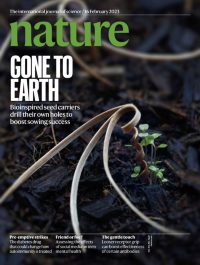Volume 614
-
No. 7949 23 February 2023
Brave new worldsIn the short time since its launch in December 2021, NASA’s James Webb Space Telescope (JWST) has generated plenty of headlines with stunning new images of the cosmos. But the telescope is about more than pictures and in this week’s issue, five papers present analyses of JWST data that demonstrate the instrument’s power in revealing fresh details about exoplanets. Between them, the teams of researchers made use of three different instruments on board the JWST — the Near InfraRed Camera, the Near InfraRed Spectrograph and the Near Infrared Imager and Slitless Spectrograph — to examine the atmosphere of the exoplanet WASP-39b. Collectively, they found signatures of water, carbon dioxide, carbon monoxide, sodium and potassium; determined the properties of clouds; and uncovered evidence of sulfur dioxide.
-
No. 7948 16 February 2023
Gone to earthUsing drones or planes to distribute plant seeds is a quick way to cover large or inaccessible areas in agriculture and reforestation. But aerial seeding can have relatively low germination rates because the seeds are not buried and so easily get blown away or eaten. In this week’s issue, Lining Yao and her colleagues present a potential solution to this problem in the shape of self-drilling seed carriers. The researchers took inspiration from Erodium, a genus of flowering plants whose seeds have coiled tails that unwind to allow the seeds to self-bury in the ground. The team used wood veneer to create a biodegradable seed carrier with three coiled tails that unwind when moistened. With two triggering cycles, the artificial seed carriers had an 80% success rate for getting seeds into flat ground, whereas the success rate for Erodium guinum was almost zero on the same terrain. The researchers note that their carriers could also be used to deliver fertilizer, fungi, or even sensors.
-
No. 7947 9 February 2023
How to make a mummyThe cover shows sarcophagi used to house the mummified remains of Ancient Egyptians in the Saqqara region of Egypt. Although the existence of mummies is well known, the details of how ancient embalmers practised their art have remained largely obscure. In this week’s issue, Maxime Rageot, Philipp Stockhammer and their colleagues draw on finds from an embalming workshop in Saqqara that dates to around 664–525 BC to reveal many of the details of the process. The researchers analysed 31 ceramic vessels found in the workshop. By combining biochemical analyses of the residues in the vessels with the inscriptions, such as “to be put on his head”, featured on many of them, they were able to establish which chemicals were used and how they were mixed, named and applied. The researchers also note that some of the embalming substances were imported from the Levant or even from south or southeast Asia, indicating that mummification might have helped to promote long-distance trade.
-
No. 7946 2 February 2023
Funky wormThe evolutionary origin of the limbless, worm-like amphibians known as caecilians is not well understood. In this week’s issue, Ben Kligman and his colleagues present fossils of the oldest-known caecilian, dating to 220 million years ago, which could help resolve the problem. The researchers identified the fossilized remains of some 76 caecilians in the Upper Triassic Chinle Formation of Petrified Forest National Park in Arizona. Named Funcusvermis gilmorei, the newly discovered species shows features found in the common ancestor of living caecilians as well as some found in an extinct group of four-legged amphibians called the dissorophoid temnospondyls. But F. gilmorei also lacks some features present in modern caecilians, which suggests it bridges the gap between modern caecilians and extinct tetrapods. An artist’s impression of F. gilmorei is shown in the foreground of the cover, together with the archosaur Acaenasuchus geoffreyi.




